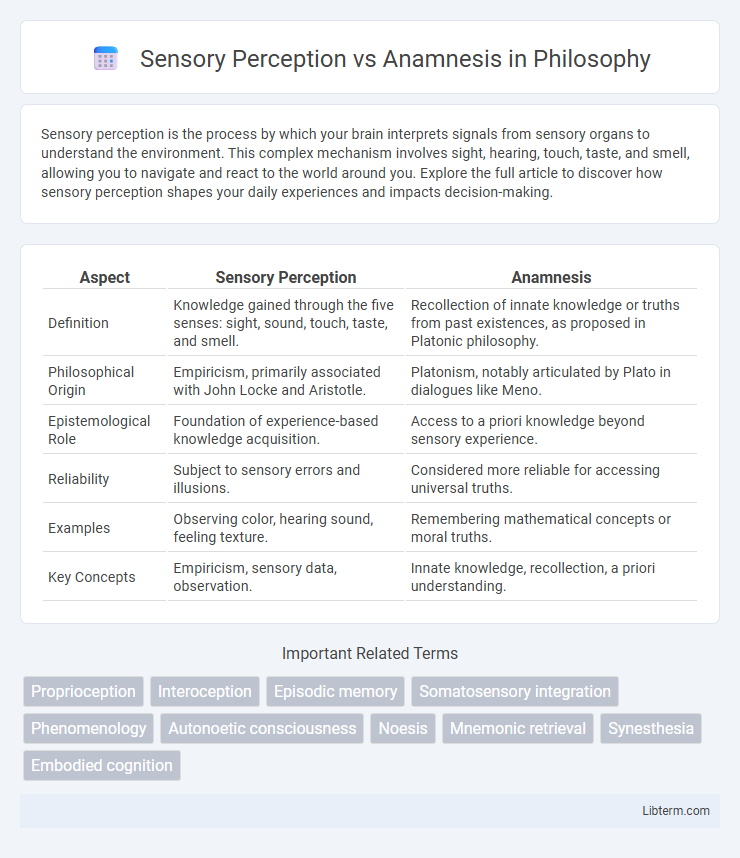Sensory perception is the process by which your brain interprets signals from sensory organs to understand the environment. This complex mechanism involves sight, hearing, touch, taste, and smell, allowing you to navigate and react to the world around you. Explore the full article to discover how sensory perception shapes your daily experiences and impacts decision-making.
Table of Comparison
| Aspect | Sensory Perception | Anamnesis |
|---|---|---|
| Definition | Knowledge gained through the five senses: sight, sound, touch, taste, and smell. | Recollection of innate knowledge or truths from past existences, as proposed in Platonic philosophy. |
| Philosophical Origin | Empiricism, primarily associated with John Locke and Aristotle. | Platonism, notably articulated by Plato in dialogues like Meno. |
| Epistemological Role | Foundation of experience-based knowledge acquisition. | Access to a priori knowledge beyond sensory experience. |
| Reliability | Subject to sensory errors and illusions. | Considered more reliable for accessing universal truths. |
| Examples | Observing color, hearing sound, feeling texture. | Remembering mathematical concepts or moral truths. |
| Key Concepts | Empiricism, sensory data, observation. | Innate knowledge, recollection, a priori understanding. |
Introduction to Sensory Perception and Anamnesis
Sensory perception involves the process by which sensory organs detect stimuli and transmit information to the brain, enabling awareness of the external environment through sight, sound, touch, taste, and smell. Anamnesis refers to the recollection of past experiences or memories, often retrieved through cognitive processes rather than immediate sensory input. Understanding the distinction between sensory perception and anamnesis is essential for fields such as neuroscience and psychology, where the differentiation between real-time sensory data and memory recall shapes human behavior and cognition.
Defining Sensory Perception: The Five Senses
Sensory perception involves the direct experience and interpretation of stimuli through the five senses: sight, hearing, touch, taste, and smell, each providing crucial data for cognitive processing. This immediate sensory input contrasts with anamnesis, which relies on recalling past experiences and memories rather than real-time sensory engagement. Understanding the five senses highlights how sensory perception forms the foundation of human interaction with the environment and informs our perception of reality.
Understanding Anamnesis: Memory and Recall
Understanding anamnesis involves exploring how memory and recall reconstruct past experiences beyond immediate sensory perception. Anamnesis integrates cognitive processes that access stored information in the brain, enabling individuals to retrieve detailed autobiographical memories that shape personal identity. This contrasts with sensory perception, which captures real-time environmental stimuli through sensory organs, highlighting the importance of memory networks in sustaining continuity over time.
Neurological Basis of Sensory Perception
Sensory perception is rooted in the neurological processing of stimuli through specialized receptors and neural pathways that transmit signals to the brain's sensory cortices, enabling real-time interpretation of environmental inputs. Anamnesis, in contrast, involves the retrieval of stored memories, engaging the hippocampus and associated cortical areas responsible for memory consolidation and recall. Understanding the distinct neurobiological mechanisms behind sensory perception and anamnesis highlights their complementary roles in shaping human experience.
The Cognitive Processes Behind Anamnesis
Anamnesis involves active cognitive processes such as memory retrieval, reconstruction, and integration of past experiences, contrasting with sensory perception which relies on immediate sensory input processing. The hippocampus and prefrontal cortex play key roles in recalling and organizing episodic memories during anamnesis. Accurate anamnesis depends on attention, working memory, and semantic networks to reconstruct coherent narratives from dispersed sensory data.
Key Differences Between Sensory Perception and Anamnesis
Sensory perception involves the direct processing of external stimuli through sensory organs, leading to immediate awareness of the environment, while anamnesis refers to the recollection or retrieval of past experiences and knowledge stored in memory. Sensory perception is inherently present-moment and relies on real-time sensory input, whereas anamnesis depends on cognitive recall mechanisms without new external sensory data. The key difference lies in perception being externally driven and time-bound, contrasting with anamnesis as an internally driven, retrospective mental process.
How Sensory Input Influences Memory Formation
Sensory perception plays a crucial role in memory formation by encoding external stimuli into neural signals that the brain processes and stores as anamnesis, or recollected experiences. The strength and clarity of sensory input, such as vivid sights, sounds, or smells, directly affect the accuracy and detail of these memories. Enhanced sensory activation can lead to more durable and accessible episodic memories, demonstrating the interplay between immediate perception and long-term memory retrieval.
The Role of Emotion in Perception and Recall
Emotions significantly influence sensory perception by enhancing the intensity and salience of stimuli, leading to more vivid and accurate initial experiences. During anamnesis, or the recall of past events, emotional states can either facilitate or distort memory retrieval, often causing certain details to be amplified or suppressed based on their emotional relevance. Neurobiological studies highlight the amygdala's crucial role in modulating both perception and memory consolidation through emotional arousal, linking affective states directly to cognitive processing during sensory input and subsequent recall.
Practical Applications: From Daily Life to Therapy
Sensory perception provides real-time data critical for navigating daily life, enabling immediate responses to environmental stimuli such as touch, sound, and visual cues. Anamnesis, the process of recalling past experiences, plays a vital role in therapeutic settings by allowing patients to access and reinterpret memories, aiding in psychological healing and cognitive assessments. Practical applications range from improving situational awareness in everyday tasks to facilitating trauma recovery and memory rehabilitation in clinical psychology.
Future Perspectives on Perception and Memory Research
Future perspectives on sensory perception and anamnesis emphasize the integration of neuroimaging and artificial intelligence to decode complex neural patterns underlying sensory experiences and memory recall. Advances in brain-computer interfaces and machine learning algorithms promise enhanced accuracy in mapping perceptual processes and reconstructing anamnetic events, facilitating personalized cognitive therapies. These innovations aim to bridge perceptual input with memory retrieval mechanisms, offering transformative potential for understanding consciousness and treating memory-related disorders.
Sensory Perception Infographic

 libterm.com
libterm.com